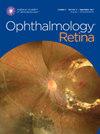Impact of Duration of Exposure to Intraretinal Fluid on Visual Outcomes in Neovascular Age-Related Macular Degeneration
IF 5.7
Q1 OPHTHALMOLOGY
引用次数: 0
Abstract
Objective
To evaluate the impact of total duration of intraretinal fluid (IRF) exposure on visual acuity and vision-related quality of life in patients with neovascular age-related macular degeneration (nAMD).
Design
A post hoc analysis of integrated data from the VIEW 1 and VIEW 2 trials.
Participants
Patients with nAMD.
Methods
Patients receiving intravitreal ranibizumab 0.5 mg every 4 weeks (Rq4) or intravitreal aflibercept injection (IAI) 2 mg every 4 weeks (2q4) or 2 mg every 8 weeks (2q8) were evaluated. Data were pooled across treatment groups, and the duration of IRF exposure was assessed by quartiles (first quartile [Q1]: ≤2 weeks; second quartile [Q2]: 3 to ≤8 weeks; third quartile [Q3]: 9 to ≤18 weeks; fourth quartile [Q4]: >18 weeks). Changes from baseline in visual acuity and vision-related quality of life were evaluated by quartiles of duration of IRF exposure in the pooled treatment group and each treatment group.
Main Outcome Measures
Mean changes from baseline in best-corrected visual acuity (BCVA) and improvement in vision-related quality of life as assessed via National Eye Institute Visual Function Questionnaire-25 (VFQ-25) composite and subscale scores at week 52.
Results
A total of 1804 patients were evaluated. In the pooled analysis, mean BCVA gains from baseline at week 52 for Q1, Q2, Q3, and Q4 were +10.9, +10.1, +9.4, and +6.6 letters, respectively (Least squares mean difference Q4–Q1 [95% confidence interval]; −4.3 [−6.1, −2.5]). Mean changes from baseline to week 52 in VFQ-25 composite score for Q1, Q2, Q3, and Q4 were +5.9, +6.6, +6.1, and +4.0 points, respectively (−1.9 [−3.6, −0.2]). A similar trend was observed across VFQ-25 subscales, with patients in Q4 generally experiencing less improvement versus Q1. When BCVA gains were assessed by quartiles of duration of IRF exposure within each treatment group, mean BCVA gains for Q1, Q2, Q3, and Q4 were +11.0, +11.1, +9.3, and +5.8 letters for Rq4 (nominal P < 0.05; Q4 vs. Q1); +10.7, +9.7, +9.2, and +7.7 letters for IAI 2q4; and +11.3, +11.2, +8.6, and +6.3 letters for IAI 2q8 (nominal P < 0.05; Q4 vs. Q1), respectively.
Conclusions
Increasing duration of IRF exposure was associated with lower visual gains and less improvement in vision-related quality of life in patients with nAMD.
Financial Disclosure(s)
Proprietary or commercial disclosure may be found in the Footnotes and Disclosures at the end of this article.
视网膜内液暴露时间对新生血管性年龄相关性黄斑变性患者视力结果的影响
目的:评价视网膜内液(IRF)暴露总时间对新生血管性年龄相关性黄斑变性(nAMD)患者视力和视力相关生活质量的影响。设计:对VIEW 1和VIEW 2试验的综合数据进行事后分析。参与者:nAMD患者。方法:观察玻璃体内注射雷尼单抗0.5 mg / 4周(Rq4)或玻璃体内注射阿布西贝2 mg / 4周(IAI 2q4)或8周(IAI 2q8)的患者。各治疗组的数据汇总,IRF暴露的持续时间按四分位数进行评估(Q1:≤2周;Q2: 3-≤8周;Q3: 9≤18周;Q4: 18周)。通过综合治疗组和各治疗组IRF暴露时间的四分位数来评估视力和视力相关生活质量与基线的变化。主要结果测量:在第52周,通过美国国家眼科研究所视觉功能问卷-25 (VFQ-25)综合评分和亚量表评分评估的最佳矫正视力(BCVA)基线的平均变化和视力相关生活质量的改善。结果:共评估1804例患者。在合并分析中,第52周时Q1、Q2、Q3和Q4相对基线的平均BCVA增益分别为+10.9、+10.1、+9.4和+6.6个字母(LS平均差Q4-Q1 [95%CI];-4.3[-6.1, -2.5])。从基线到第52周,Q1、Q2、Q3和Q4的VFQ-25综合评分的平均变化分别为+5.9、+6.6、+6.1和+4.0分(-1.9[-3.6,-0.2])。在VFQ-25亚量表中也观察到类似的趋势,与Q1相比,Q4的患者通常改善较少。当以每个治疗组中IRF暴露时间的四分位数来评估BCVA增益时,Q1、Q2、Q3和Q4的BCVA平均增益分别为+11.0、+11.1、+9.3和+5.8个字母(标称p4)。结论:IRF暴露时间的增加与nAMD患者视力增益降低和视力相关生活质量改善较少相关。
本文章由计算机程序翻译,如有差异,请以英文原文为准。
求助全文
约1分钟内获得全文
求助全文

 求助内容:
求助内容: 应助结果提醒方式:
应助结果提醒方式:


